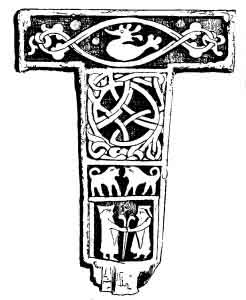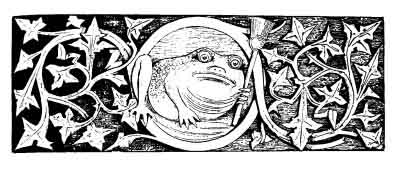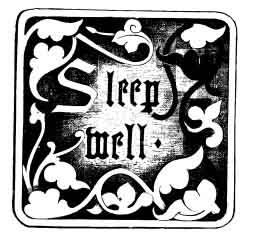
Gypsy Sorcery and Fortune Telling, by Charles Godfrey Leland, [1891], at sacred-texts.com
CHAPTER XVI
GYPSIES, TOADS, AND TOAD-LORE
"I went to the toad that lies under the wall,
I charmed him out, and he came at my call."
Masque, of Queens," BEN JONSON.)
 THE toad plays a prominent part in gypsy (as in other) witchcraft, which it may well do, since in most Romany dialects there is the same word for a toad or frog, and the devil. PASPATI declares that the toad suggested Satan, but I incline to think that there is some as yet undiscovered Aryan word, such as beng, for the devil, and that the German Bengel, a rascal, is a descendant from it. However, gypsies and toads are "near allied and that not wide" from one another, and sometimes their children have them for pets, which recals the statements made in the celebrated witch trials in Sweden, where it was said by those who professed to have been at the Blockula, or Sabbat, that the little witch
THE toad plays a prominent part in gypsy (as in other) witchcraft, which it may well do, since in most Romany dialects there is the same word for a toad or frog, and the devil. PASPATI declares that the toad suggested Satan, but I incline to think that there is some as yet undiscovered Aryan word, such as beng, for the devil, and that the German Bengel, a rascal, is a descendant from it. However, gypsies and toads are "near allied and that not wide" from one another, and sometimes their children have them for pets, which recals the statements made in the celebrated witch trials in Sweden, where it was said by those who professed to have been at the Blockula, or Sabbat, that the little witch
children were set to play at being shepherds, their flocks being of toads.
I have been informed by gypsies that toads do really form unaccountable predilections for persons and places. The following is accurately related as it was told me in Romany fourteen years ago, in Epping Forest, by a girl. "You know, sir, that people who live out of doors all the time, as we do, see and know a great deal about such creatures. One day we went to a farmhouse, and found the wife almost dying because she thought she was bewitched by a woman who came every day in the form of a great toad to her door and looked in. And, sure enough, while she was talking the toad came, and the woman was taken in such a way with fright that I thought she'd have died. But I had a laugh to myself; for I knew that toads have such ways, and can not only be tamed, but will almost tame themselves. So we gypsies talked together in Romany, and then said we could remove the spell if she would get us a pair of shears and a cup of salt. Then we caught the toad, and tied the shears so as to make a cross—you see!—and with it threw the toad into the fire, and poured the salt on it. So the witchcraft was ended, and the lady gave us a good meal and ten shillings." (For a Romany poem on this incident vide "English Gypsy Songs," Trübner and Co., 1875). And there is a terrible tale told by R. H. Stoddard, in a poem, that one day a gentleman accidentally trod on a toad and killed it. Hearing a scream at that instant in the woods at a little distance, followed by an outcry, he went to see what was the matter, and found a gypsy camp where they were lamenting the sudden death of a child. On looking at the corpse he was horrified to observe that it presented every appearance of having been trampled to death, its wounds being the same as those he had inflicted on the toad. This story being told by me to the gypsy girl, she in no wise doubted its truth, being in fact greatly horrified at it; but was amazed at the child chovihani, or witch, being in two places at once.
In the Spanish Association of Witches in the year 1610 (vide Lorent, "Histoire de l'Inquisition") the toad played a great part. One who had
taken his degrees in this Order testified that, on admission, a mark like a toad was stamped on his eyelid, and that a real toad was given to him which had the power to make its master invisible, to transport him to distant places, and change him to the form of many kinds of animals. There is a German interjection or curse "Kroten-düvel!" or "toad-devil," which is supposed to have originated as follows: When the Emperor Charlemagne came into the country of the East Saxons and asked them whom they worshipped they replied, "Krodo is our god;" to which the Emperor replied "Krodo is all the same as Kroten-düvel!" "And he made them pay bitterly by the sword and the rope for the crime of calling God, according to their language, by a name different from that which he used; for he put many thousands of them to death, like King Olof of Norway, to show that his faith was one of meekness and mercy."
It is bad to have one's looks against one. The personal appearance of the toad is such as to have giver it a bad place in the mythology of all races. The Algonkin Indians—who, like Napoleon and Slawkenbergius, were great admirers of men with fine bold noses—after having studied the plane physiognomy of the toad, decided that it indicated all the vices, and made of the creature the mother of all the witches. Nothing could have been more condemnatory; since in their religion—as in that of the Accadians, Laps, and Eskimo—a dark and horrible sorcery, in which witches conciliated evil spirits, was believed to have preceded their own nobler Shamanism, by which these enemies of mankind were forced or conquered by magic. Once the Great Toad had, as she thought, succeeded in organizing a conspiracy by which Glooskap, the Shamanic god of Nature, was to be destroyed. Then he passed his hand over her face and that of her fellow-conspirator the Porcupine; and from that time forth their noses were flat, to the great scorn of all honest well-beaked Indians.
The old Persians made the toad the symbol and pet of Ahriman, the foe of light, and declared that his Charfester, or attendant demons, took that form when they persecuted Ormuzd. Among the Tyrolese it is a type of envy; whence the proverb, "Envious as a toad." In the Middle
Ages, among artists and in many Church legends, it appears as Greed or Avarice: there is even to this day, in some mysterious place on the right bank of the Rhine between Laufenberg and Binzgau, a pile of coals on which sits a toad. That is to say, coals they seem to the world. But the pile is all pure gold, and the toad is a devil who guards it; and he who knows how can pronounce a spell which shall ban the grim guardian. And there is a story told by Menzel ("Christliche Symbolik," vol. i. p. 530), that long ago there lived in Cologne a wicked miser, who when old repented and wished to leave his money to the poor. But when he opened his great iron chest, he found that every coin in it had turned to a horrible toad with sharp teeth. This story being told to his confessor, the priest saw in it divine retribution, and told him that God would have none of his money—nay, that it would go hard with him to save his soul. And he, being willing to do anything to be free of sin, was locked up in the chest with the toads; and lo! the next day when it was opened the creatures had eaten him up. Only his clean-picked bones remained.
But in the Tyrol it is believed that the toads are themselves poor sinners, undergoing penance as Hoetschen or Hoppinen—as they are locally called—for deeds done in human form. Therefore, they are regarded with pity and sympathy by all good Christians. And it is well known that in the Church of Saint Michael in Schwatz, on the evening before the great festivals, but when no one is present, an immense toad comes crawling before the altar, where it kneels and prays, weeping bitterly. The general belief is that toads are for the most part people who made vows to go on pilgrimages, and died with the vows unfulfilled. So the poor creatures go hopping about astray, bewildered and perplexed, striving to find their way to shrines which have perchance long since ceased to exist. Once there was a toad who took seven years to go from Leifers to Weissenstein; and when the creature reached the church it suddenly changed to a resplendent white dove, which, flying up to heaven, vanished before the eyes of a large company there assembled, who bore witness to the miracle. And one day as a wagoner was going from Innsbruck to Seefeld, as he
paused by the wayside a toad came hopping up and seemed to be desirous of getting into the wagon; which he, being a benevolent man, helped it to do, and gave it a place on the seat beside him. There it sat like any other respectable passenger, until they came to the side-path which leads to the church of Seefield; when, wonderful to relate! the toad suddenly turned to a maiden of angelic beauty clad in white, who, thanking the wagoner for his kindness to her when she was but a poor reptile, told him that she had once been a young lady who had vowed a pilgrimage to the church of Seefield.
In common with the frog, the toad is an emblem of productiveness, and ranks among creatures which are types of erotic passion. I have in my possession a necklace of rudely made silver toads, of Arab workmanship, intended to be worn by women who wish to become mothers. Therefore the creature, in the Old World as well as in the New, appears as a being earnestly seeking the companionship of men. Thus it happened to a youth of Aramsach, near Kattenberg, that, being one day in a lonely place by a lake, there looked up at him from the water a being somewhat like a maid but more like a hideous toad, with whom he entered into conversation; which became at last friendly and agreeable, for the strange creature talked exceeding well. Then she, thinking he might be hungry, asked him if he would fain have anything in particular to eat. He mentioned in jest a kind of cakes; whereupon, diving into the lake, she brought some up, which he ate. So he met her many times; and whenever he wished for anything, no matter what, she got it for him from the waters: the end of it all being that, despite her appalling ugliness, the youth fell in love with her and offered marriage, to which she joyfully consented. But no sooner had the ceremony been performed than she changed to a lady of wonderful beauty; and, taking him by the hand, she conducted him to the lake, into which she led him, and "in this life they were seen never more." This legend evidently belongs to frog-lore. According to one version, the toad after marriage goes to a lake, washes away her ugliness, and returns as a beauty with the bridegroom to his castle, where they live in perfect happiness.
I have also a very old silver ring, in which there is set a toad rudely yet artistically carved in hæmatite, or blood-stone. These were famous amulets until within two or three hundred years.
If you are a gypsy and have a tame toad it is a great assistance in telling fortunes, and brings luck—that commodity which, as CALLOT observed, the gypsies are always selling to everybody while they protest they themselves have none. As I tested with the last old gypsy woman whom I met: "What bâk the divvus?"—"What luck to-day?" "Kekker rya"—"None, sir," was the reply, as usual,—"I never have any luck." So like a mirror they reflect all things save themselves, and show you what they know not.
"I've seen you where you never were
And where you never will be
And yet within that very place
You can be seen by me.
For to tell what they do not know
Is the art of the Romany."


